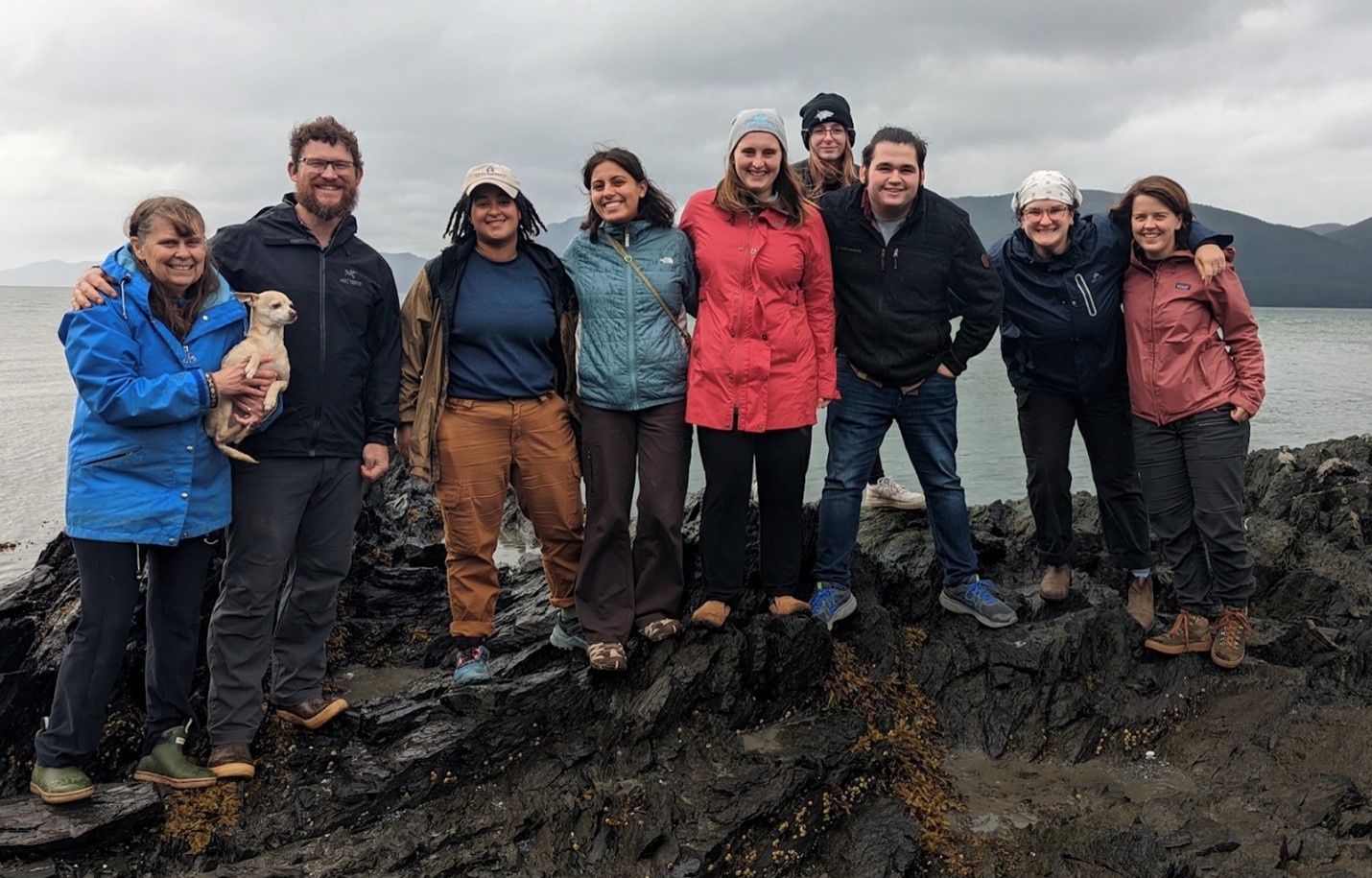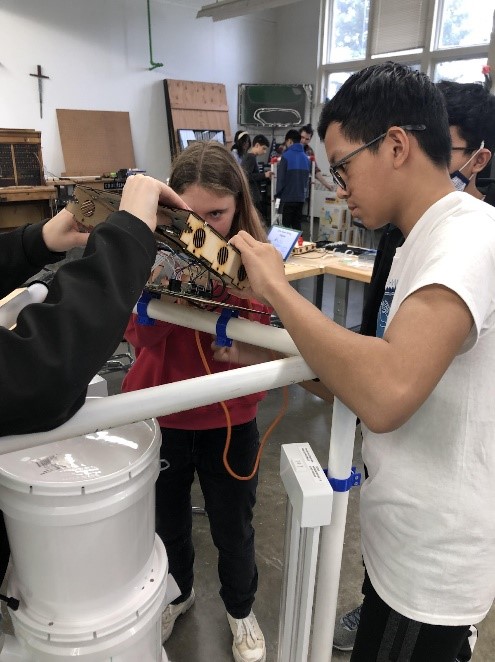Education, Innovation and Leadership: Field Notes from Cordova
By Sarah Burch and Savannah Crichton
Oct. 13, 2022
The dirt path twisted along Eccles Creek and bent to the swatches of moss, tree roots and foliage that carpeted the forested area. After a bit of a walk, our group came upon a charming neighborhood of six houses, one of which belongs to Anita and Dana Smyke.
Leading the experience was UAF’s Upward Bound associate director, Brian Reggiani, and the program’s director, Adam Low, both of whom have strong Cordova ties. Reggiani grew up with the Smykes’ kids, and Low was their science teacher at Cordova High School. The Smykes welcomed our group into their home and everyone piled onto the couch to eat cookies, reminisce and discuss the future of science education.
We were among this group. We are Sarah Burch — ACEP’s newest energy fellow for the Alaska Microgrid Group, focusing on grid projects throughout Alaska — and Savannah Crichton — ACEP’s learning designer fellow, working on energy curriculum design. We both came into this opportunity through the Alaska Fellows Program, which pairs future leaders with community and professional mentors in Alaska.
During our time with Anita, she recounted her 20-plus years of experience as the local lead for the Future Problem Solver Program and Girl Scouts, along with the travel experiences and programs she ran within them, like Women in Science. She focused on bringing young kids together to create, learn and expand their horizons — essential tools to community growth in a place like Cordova. Anita said that she let the students lead. “I would just put them all together and they would come up with projects,” she said.
In communities as small as Cordova, with a winter population of around 2,500, each community member has the capacity to bring real change and guide the direction of the city. When Anita retired from her roles in FPSP and the Girl Scouts, there were few others who were able to take on the responsibilities of those programs. This really made us think. How can we support leaders and programs in small communities so that there is a new generation of leaders to carry on legacies like Anita’s?
After filling our stomachs with cookies and our souls with stories, the Smykes took us on a beach trek to the shore of Orca Inlet, stepping over kelp as we watched otters splash in the bay. Both Dana and Anita described the unique geology and wildlife of the region. While the Smykes’ connection to the land was evident, we also discovered their much deeper connection to the people of Cordova. Both Anita and Dana are a part of a network of community members who are essential to the city’s innovative spirit.

Meeting community leader Anita Smyke on the coastline near her home. Left to right, Anita Smyke, Adam Low, Asma Alomari, Savannah Crichton, Ashley Guernsey, Cailin Yaeger, Petie Deever, Sarah Burch, and Gracie Farnham.
Next on the itinerary was a meeting with Clay Koplin, the CEO of the Cordova Electric Cooperative and Cordova’s former mayor. As a long-time leader in the small coastal town, Koplin has played many important roles for Cordova, but his approach to leadership and problem solving remains steady through the years. Koplin believes in encouraging his community to be informed of what is happening locally and empowers them to be the problem solvers and innovators that guide Cordova’s future.
For example, Koplin went to Low’s high school science class to ask for help with CEC’s energy storage problem. There currently isn’t any storage method for the hydropower that Cordova relies on, even though the two renewable power plants overproduce between 3 gigawatt hours (3,000,000 kilowatt hours) and 5 GWh per year. While Koplin has tried to solve this problem internally, he thought asking the fresh young minds of Cordova High could lead to new answers. Though the CEC is still figuring out how to store extra hydropower in the summer in order to offset diesel use in the winter, engaging the youth in such an impactful problem is a road not many would have taken. Seeing how a utility leader reached out to engage youth in the community to solve an energy issue was something that really stuck with us and makes us wonder: “Is this going on in other communities?”
For community leaders, like Koplin, to reach out to students to help solve a community-scale problem, we need teachers who are also committed to a real-world educational curriculum — like Krysta Williams, a science teacher and Cordova High School’s T3 Alliance Coach. T3, or Teaching Through Technology, is an international organization focused on helping students in underserved communities learn about STEM education. They have locations from Alaska to Puerto Rico and teach both educators and students how they can use their technological knowledge throughout their communities.
While in Cordova, we had the opportunity to help deliver an automated hydroponic grow tower, designed by UAF Makerspace lab techs Petie Deever and Cailin Yeager, to Williams’ T3 club. Deever and Yeager have been working on the tower’s design since they were high school students in the T3/Upward Bound program. Now in their second year of college, they stood before a group of students, ready to pass on their knowledge.
The two undergraduates explained how the grow tower is connected to food security and nutritious meals. By extending Alaska’s growing season with hydroponics and grow lights, rural locations can increase access to leafy greens, vegetables and herbs throughout the entire winter. An innovative microcontroller is wired to automate the grow lights and the water pump, making experimentation with seeds, fertilizer and harvest perfect for the curious classroom.

A group of students at Cordova High School working on assembling the automation system for the grow tower.
The grow tower will undoubtedly have an impact on students’ lunch tables, but growing roots of confidence and sparking curiosity is perhaps the deeper impact of this project. We watched as students encountered and worked through problems by making mistakes, learning how to use power drills and wiring diagrams, and asking questions along the way. Deever and Yaeger were encouraged to see the group work iteratively through their challenges. “That’s what we’re going for in T3,” remarked Deever. “It’s not going to be perfect, but all you can do is try.”
This sort of learning is what T3 is striving to do. Williams welcomed new and old students as they bounced into the classroom’s open doors. As part of the National Science Teaching Association and the Alaska Science Teaching Association, Williams is an incredibly innovative science educator. She was selected to participate in the 2019 Smithsonian National Air and Space Museum's Teacher Innovator Institute and as a state finalist for the 2022 Presidential Award for Excellent Math and Science Teachers. Williams’ teaching philosophy aligns with the mission of T3: guiding students through engaging activities where there’s no correct answer, while teaching them to observe, giving them autonomy and watching them learn.
Seeing the multiple hats Williams wears in the classroom and her community — as a teacher, Girl Scout leader and Cordova Public Library board member — only emphasized the need for institutional support.
T3 coaches become part of an Alaskawide and global community of educators who believe design thinking is an essential methodology for the production of equitable science instruction.
“T3 has also provided opportunities for me to connect with like-minded colleagues across the state, creating opportunities to expand my repertoire and introduce creative teaching strategies into the club and the classroom,” said Williams.
Williams’ perspective on T3 supporting advisors along with the students is important. It shows how larger organizations, like ACEP, can support remote communities in their energy and education needs.
We both plan to use the knowledge we gained in Cordova in our work at ACEP. Savannah plans to integrate the work of researchers and mariculture farmers into other projects centering energy-based curriculum. Sarah, on the other hand, believes that the community support and innovation we saw in Cordova can be assisted through AMG, which is focused on using our experts’ knowledge to help Alaska communities improve their grids.
We walked away from our time in Cordova inspired by the tight-knit community and energized with new ideas for energy-based learning. We realized that innovation is not fully about technological advancements but more about the people involved — innovators, mayors, utility experts, teachers — who are sometimes all one person. We saw that inviting the community into the classroom creates rich opportunities for equitable, place-based education. We are excited to stay connected with our new colleagues in Cordova and hope to bring an equal level of passion for energy, education and community that we experienced during our trip and carry that throughout our fellowship.
These efforts were made possible by funding from the Office of Naval Research’s Alaska Regional Collaboration for Technology Innovation and Commercialization program.


